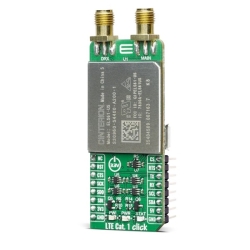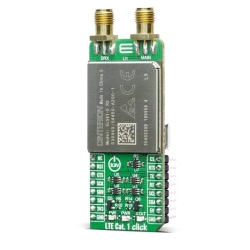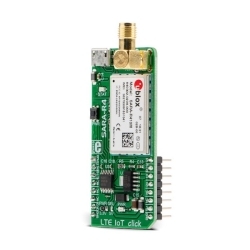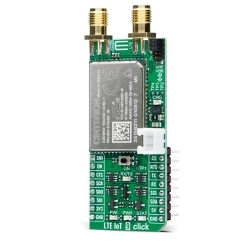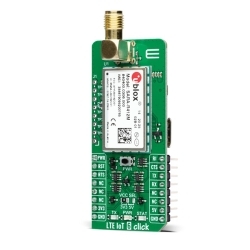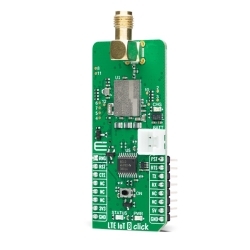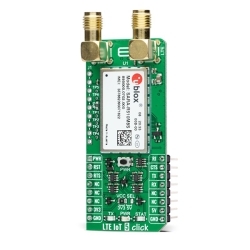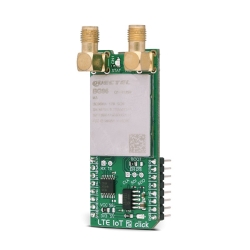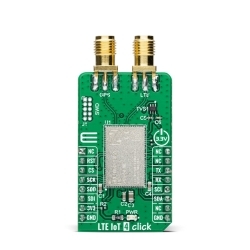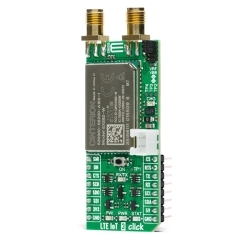MIKROE LTE IoT 7 Click
LTE IoT 7 Click is an add-on board representing a secure-cloud multi-band solution designed for IoT applications.
Product Overview
LTE IoT 7 Click is an add-on board representing a secure-cloud multi-band solution designed for IoT applications. This board features the SARA-R422M8S, a multi-band LTE-M/NB-IoT/EGPRS multi-mode solution with integrated high-performance standard precision M8 GNSS receiver for global position acquisition from u-blox. Equipped with familiar AT commands set over the UART interface, USB interface, and Network and Status indicators, it also provides over-the-air firmware updates, end-to-end trusted domain security, and u-Blox’s leading GNSS technology. This Click board™ is ideal for mission-critical IoT applications, as they include a unique and immutable root-of-trust, such as connected healthcare, industrial monitoring, point of sale and vending terminals, and many more.
LTE IoT 7 Click, as its foundation, uses the SARA-R422M8S, a multi-band LTE-M/NB-IoT/EGPRS multi-mode cellular module from u-blox. It comes in a miniature SARA LGA form factor module that is a drop-in migration from other u-blox cellular module families. The SARA-R422M8S modules provide software-based multi-band configurability enabling global coverage in LTE-M / NB-IoT and (E)GPRS radio access technologies, supporting a comprehensive set of 3GPP Rel. 14 features relevant for IoT applications.
The SARA-R422M8S module is ideal for mission-critical IoT solutions for its unique and immutable root-of-trust. It supports IoT Security-as-a-Service and provides the foundation for a trusted set of advanced security functionalities. The scalable, pre-shared key management system offers best-in-class data encryption and decryption, both on-device and from device-to-cloud. Utilizing the latest (D)TLS stack and cipher suites with hardware-based crypto acceleration provides robust, efficient, and protected communication.
This module requires a power supply of 3.8V. Therefore, the Click board™ incorporates an integrated buck (step-down DC-DC) converter, labeled as TPS7A7002 by Texas Instruments, which provides a stable 3.8V power supply, capable of mitigating voltage drops at the input when a high current peak appears (typically at the StartUp of the device).
The SARA-R422M8S communicates with MCU using the UART interface with commonly used UART RX and TX pins with the hardware flow control pins UART CTS, RTS, RI (Clear to Send, Ready to Send, and Ring Indicator). It operates at 115200 bps by default configuration to transmit and exchange data with the host MCU through AT commands that u-blox provides. It is also equipped with a USB type C connector, available for diagnostic purposes only. The module acts as a USB device and can be connected to any USB host equipped with compatible drivers.
The push-button labeled PWR routed to the AN pin on the mikroBUS™ socket represents the Ignition (Power-On) button, where a yellow STAT LED indicates a successful action. If the device is already powered up, a LOW pulse with a duration of 1.5s on this pin will power the module down. Among its used pins, this Click board™ also has a GNSS external interrupt to control the GNSS receiver or to aid. It possesses three additional LED indicators: the yellow LED labeled as STAT used to visually indicate the Operational Status of the device, a red LED labeled as TX used to tell the Network Status, and an orange LED indicator marked as PPS used for time pulse signal information and indication.
The GNSS RF input of the SARA-R422M8S, designed with 50Ω characteristic impedance and an internal DC block, is suitable for both active or passive GNSS antennas due to the built-in SAW filter followed by an LNA in front of the integrated high-performing u-blox M8 concurrent positioning engine. Besides those SMA connectors (for LTE and GNSS antennas), the LTE IoT 7 Click also has a Nano-SIM card slot that provides multiple connections and interface options. The J1 header allows you to access the configurable GPIO and GNSS Data output from internal u-blox GNSS, while test points labeled from TP1 to TP6 enable easy FW upgrades and testing of the module.
Customers can future-proof their solutions through over-the-air firmware updates, thanks to the uFOTA client/server solution that utilizes LWM2M, a light and compact protocol ideal for IoT. As mentioned, we have also provided accessible test points directly connected to the TxD and RxD pins for FW upgrade purposes.
This Click board™ can operate with both 3.3V and 5V logic voltage levels selected via the VCC SEL jumper. This way, it is allowed for both 3.3V and 5V capable MCUs to use the communication lines properly. However, the Click board™ comes equipped with a library containing easy-to-use functions and an example code that can be used, as a reference, for further development.
Features & Specs
- Interface: GPIO, UART, USB
- Compatibility: mikroBUS™
- Dimensions: 57.15 x 25.4mm
- Input Voltage: 3.3V or 5V
- Supply Voltage: Min. 3.3V, Max. 5V
- Operating Frequency: Min. 700MHz, Max. 2100MHz
- Operating Temperature Range: Min. -20°C, Typ. +25°C, Max. +65°C
Customer Reviews
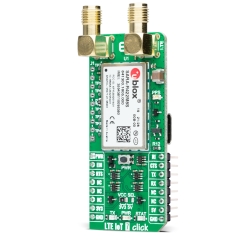
Stock and Customer Discounts
Available Discounts
- $80.70 | 25+ units
- $76.46 | 100+ units


